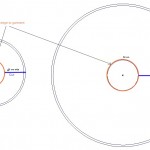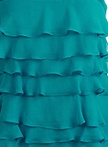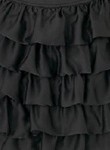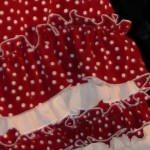There are two basic types of ruffles: Circular ruffles and gathered ruffles.
As fashion changes one or the other type becomes more popular. Most of the ruffles I make at the moment are circular
ruffles. You will find them at the hem of skirts and dresses but sleeves and necklines also often sport ruffles. They come in a huge variety of shapes and sizes. Which type, size and how many ruffles you choose for any particular outfit depends on the effect you are trying to achieve. Just keep in mind:
- The bigger the ruffles are and the more volume they have at the bottom the heavier your flamenco outfit will be and, of course, the more fabric you will need.
 Then you cut the resulting ring open (along the blue line in the drawing), connect the required number of circles (sew the cut open edges together to form one long ruffle) and, after finishing both edges, sew the inner edge (orange in the drawing) to the garment. The edge sewn to the garment is smaller than the outer edge – this is what creates the flare we are after. The bigger the difference of the two circles’ diameter the more flare is created. For lots of volume cut the inner circle small
Then you cut the resulting ring open (along the blue line in the drawing), connect the required number of circles (sew the cut open edges together to form one long ruffle) and, after finishing both edges, sew the inner edge (orange in the drawing) to the garment. The edge sewn to the garment is smaller than the outer edge – this is what creates the flare we are after. The bigger the difference of the two circles’ diameter the more flare is created. For lots of volume cut the inner circle small  For a soft, wavy effect cut a bigger inner circle
For a soft, wavy effect cut a bigger inner circle 
To calculate how many circles you need for your ruffle measure the hem of your skirt (or wherever the ruffle goes), for example 4m. Then measure the diameter of the inner circle of your ruffle and divide the length of the hem by
this measurement. In our example, lets say we want to use the big ruffle shown in the drawing above, we divide 4m by 0.5m and find that we will need to cut 8 circles and sew them together to form the required 4m ruffle.
Gathered ruffles
 are cut from one or several rectangular pieces of fabric, joined at the short edge, where one long edge is gathered to create the ruffle. For the gathering I use a special presser foot on my sewing machine. If you plan to gather fabric more than once or twice I can only recommend you check whether there is one available for your sewing machine. It really takes the hassle out of the task. You can of course create gathered ruffles by hand or using the normal functionality of your sewing machine. For instructions check out this tutorial.
are cut from one or several rectangular pieces of fabric, joined at the short edge, where one long edge is gathered to create the ruffle. For the gathering I use a special presser foot on my sewing machine. If you plan to gather fabric more than once or twice I can only recommend you check whether there is one available for your sewing machine. It really takes the hassle out of the task. You can of course create gathered ruffles by hand or using the normal functionality of your sewing machine. For instructions check out this tutorial.Similar to circular ruffles, the more you gather the more flare you achieve and the longer your fabric strip must be (usually somewhere between 1.5 to 3 times the desired length). You can cut a narrow strip and gather it in the middle or a wider strip and gather close to the long edge. This latter type you can sew to your garment with both long edges showing
 or, especially if the ruffle is sewn directly to the hem of your skirt, only show the bottom gathered part like in the picture of the black ruffles above.
or, especially if the ruffle is sewn directly to the hem of your skirt, only show the bottom gathered part like in the picture of the black ruffles above.Ruffle Finish
Finish the edge of the ruffle you will be sewing to the garment the same way as the rest of your flamenco dress: use a serger (or overlocker) or your sewing machine’s zic-zac stitch etc. To give the visible part of the ruffles a nice finish there are again two basic options:
- a tight rolled hem stitch using a serger (overlocker). This is what I do in most cases or
- finish the ruffle with a bias binding. You can also attach some lace or a small ruffle.
There are unlimited options. Play with contrasting fabrics for the actual ruffles, finish the ruffles in contrasting colours, combine ruffle types and sizes, attach ruffles horizontally or vertically, create ruffles by gathering the inner edge of a circular ruffle for extra volume etc. Just let your imagination run wild or check out the Flamencreaciones gallery for inspiration and, most importantly, have fun!

No hay comentarios:
Publicar un comentario